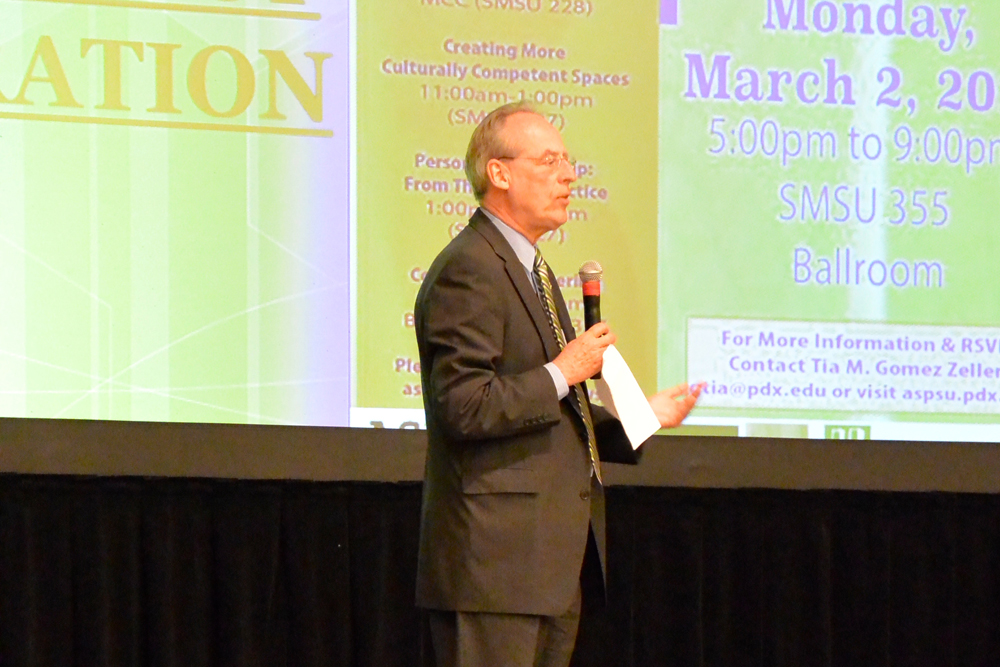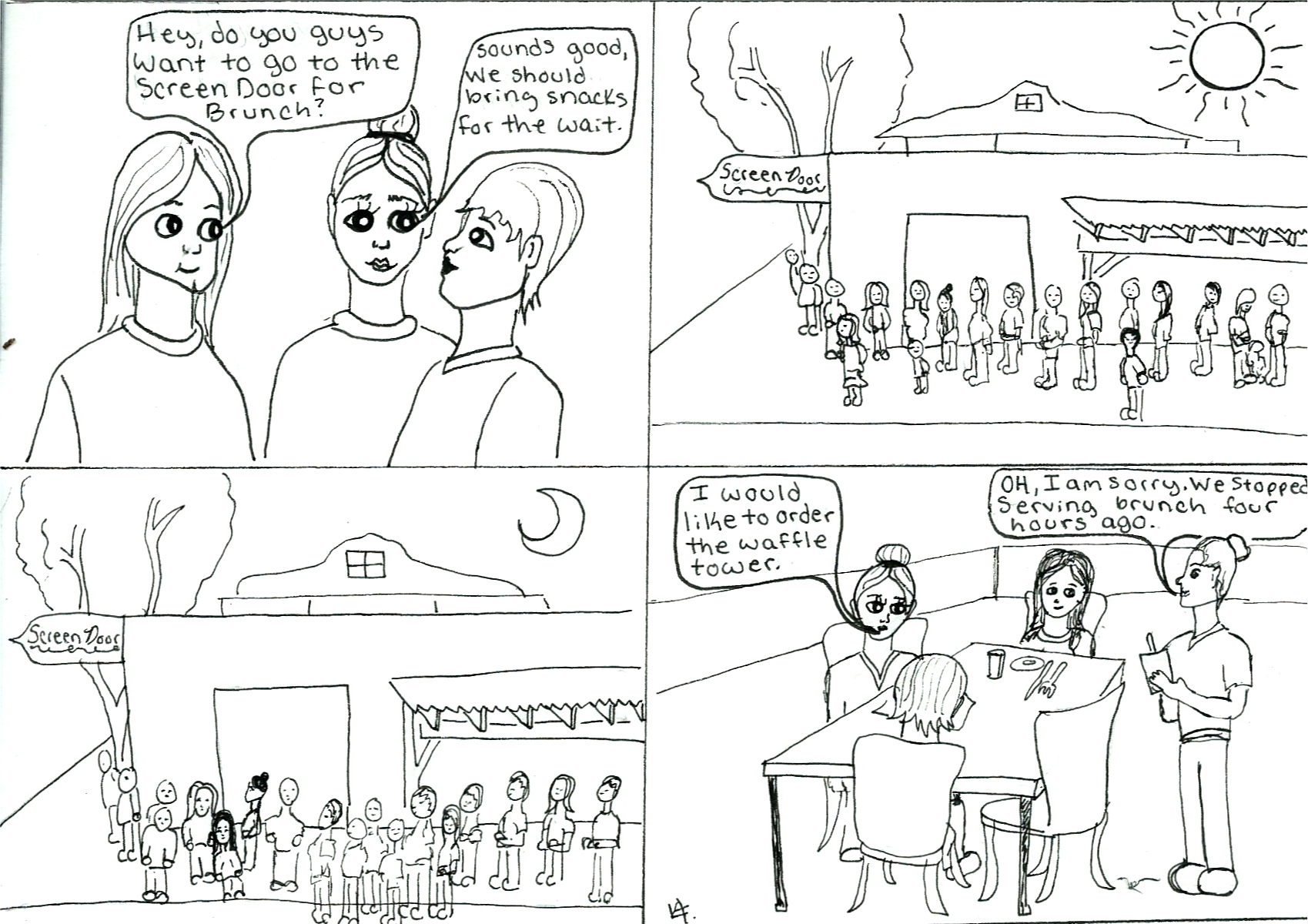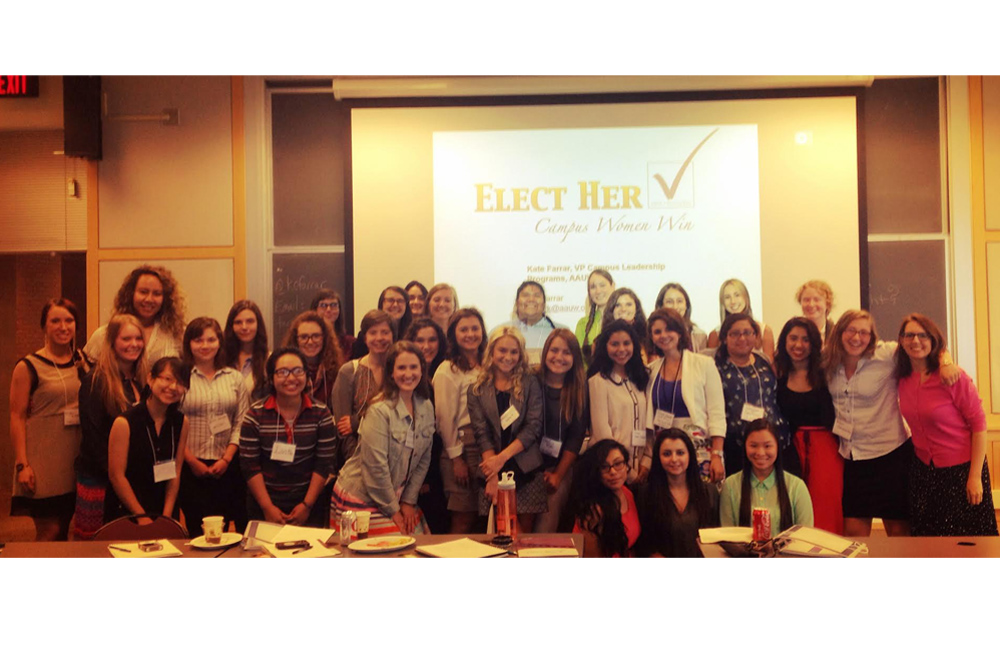The Office of the President hosted its quarterly Student Media press conference for all student media groups on campus on March 3. Representatives from the Vanguard and the Rearguard were present.
President Wim Wiewel discussed campus safety, upcoming construction projects and the upcoming legislative session in Salem, among other topics.
Wiewel said Portland State is ready to break ground on the addition of a new School of Business Administration building and start renovations on the current SBA facilities this August.
The Viking Pavilion and Peter W. Stott Center project is expected to break ground as early as January 2016 with a projected completion date in early 2018. The project is estimated to cost $20 million. There are plans to raise an additional $4 million in order to ensure the building is the most ideal space for students. The majority of money raised has been from donors and the legislature.
“Since we last met, the Student Fee Committee agreed to invest $1.5 million of the building fee in the [Viking Pavilion], because it will be a very important social space, meeting space, informal student space, which was, frankly, the thing that made me decide to support the project,” he said.
“The thing we’re spending the most time on is the Strategic Plan,” he said. The Strategic Plan is a document outlining goals to promote PSU’s vision and initiatives. Wiewel said between the Strategic Plan Development Team and eight topic teams—sub-committees that tackles specific goals within the plan—there are about 100 people actively involved in molding PSU’s future.
Wiewel talked about PSU’s future with an armed police force as well. He said that the Board of Trustees’ Implementation Advisory Committee, the committee planning the implementation of armed officers on campus, has had several meetings, focusing on recruitment, training, use of force and oversight policies.
Wiewel also praised the research, both practical and theoretical, being done on campus, including recent research on formaldehyde levels in e-cigarettes that brought the school national media attention. “It’s about advancing knowledge.”
He emphasized the need to balance both local engagement and a global emphasis. Though PSU is conducting research that’s relevant to the world, he said, “It is that local engagement that makes us unique, because nobody else is as engaged with Portland as we are.”
Following his introductory speech, Wiewel then opened the meeting up to a question-and-answer session.
Vanguard: Do you see the resignation of Governor Kitzhaber and subsequent appointment of Gov. Brown impacting any of the goings-on at PSU right now?
President Wim Wiewel: I am very pleased to have somebody who clearly appreciates the importance of students. I like having a governor who understands the Portland region very well…I think Gov. Kitzhaber was very active and did good things when it comes to higher education, but I think Gov. Brown will be a very good successor, so we look forward to working with her.
VG: Will Brown’s budget affect higher education spending?
WW: [Kitzhaber’s] budget recommended $608 million, [but] that had already become old news, because the co-chairs released their framework in late January, and they recommended $670 million. So, Brown is not doing her own budget. It’s kind of beside the point now. The co-chairs said that, if there were more money, they would recommend an additional $15 million…If the economy keeps growing fast, then there will be more money for the biennium so they can allocate more.
Rearguard: If you don’t receive the necessary funds, how much, percentage-wise, will tuition rise?
WW: For undergraduate residents, we’re talking about the ballpark of 4.5 percent. It’s more than I’d ideally like. For graduate and out-of-state students, the increase will be about 3 percent. If we get more than what the co-chairs now recommend, we will reduce that percentage increase. For undergraduate residents, that would be about $350 per year increase.
RG: Would that be a term-by-term increase or for the whole year?
WW: That would be for the whole year. It’s X amount of dollars per credit hour, and that’s fixed for the rest of the year.
VG: What are you hoping for in the upcoming ASPSU election?
WW: I’m hoping for very strong slates that do a great job campaigning. I think it’s a great way to engage more students in the university both generally and in the particular issues that might be relevant…I hope that the rules of the game can be clear enough that it will not be hard for people to stick to the rules, because it’s very frustrating when people work hard, then they wind up being declared ineligible whether they knew they were breaking the rules or didn’t. It’s frustrating, and it doesn’t help the legitimacy, as you know. At the beginning of the year [there were] a lot of struggles about what had happened and [it] just slows people down…rather than just dealing with the issues that you want student government to deal with.
VG: So what are these particular issues that might be relevant?
WW: That is up to the slates to figure out. That’s not my call. I hope that the slates think about: What are the things that matter to students, and what are the things that a student government can actually affect?…It doesn’t make sense to talk about a lot of stuff that student government can’t do anything about anyway. Focus on the things where student government can make a difference.
VG: What work are you doing with ASPSU right now?
WW: The main focus is on the legislative agenda, primarily focused on the operational funding…We meet every month with Eric Noll and Rayleen [McMillan] to talk about everything that’s going on, things that they need our help on or that we need their help on.
Tuition, we have, of course, talked with them and with the Student Budget Advisory Committee. And I have to say, we’ve had an excellent relationship even when we disagree. [For instance] as you know, the stance of ASPSU is that there should be a zero percent tuition increase, which they have tied very closely to pushing for the $755 million.
VG: You said that there are some exciting things coming out of strategic planning. Could you talk about what some of those things are?
WW: Just these debates that people are having that make them see that their colleagues see the world somewhat differently. Ultimately…this university is remarkably united around the ultimate mission of the university, which is ‘Let knowledge serve the city.’
VG: In terms of the renovation of Neuberger, you said it’s on the list, and it’s been a long-standing need. So why not do that before the Viking Pavilion?
WW: Because we don’t have the money yet. The legislature has to approve that money now, and so, if they approve it in this session—which we expect—the bonds won’t be issued until two years later. They issue them, then, in spring 2017…It’s kind of a little game that the legislature plays, that they approve it in this session for the next biennium, but the next biennium they don’t actually have to allocate the funds…until the very end of the biennium.
And the reason we went with the Stott Center to the legislature in 2013, rather than Neuberger, is that we had donors who were going to come up with the money to match that. Neuberger doesn’t require nearly as much match-money as the Viking Pavilion, and I didn’t think that those dollars would stand around and cool their heels for another two years. It was kind of a tactical decision: This way we were going to be able to do both of the projects by essentially flipping the sequence that we might otherwise have had. [Doing Neuberger first, “centrality of the building”] the Stott Center never would have happened, because the state wasn’t going to give us the bulk of the money the way they will for Neuberger.
VG: With new things like the Viking Pavilion, the renovation of the Stott Center, and now the introduction of Mark Rountree, where do you see Athletics fitting into the PSU community in the future?
WW: The role of athletics in American universities is a pretty unique phenomenon on a global scale…For schools of a certain size, athletics are a big part of identity. Students and alumni identify with it. It gives you more press coverage…even in the Vanguard, sports gets 2 or 3 pages every week, which, for something that involves 285 students, it’s, in a way disproportionate, because it captures people’s attention in a way that biology or english just don’t. At its best, you can take advantage of that. I think we have a long way to go at PSU, [but] it can be a great source of pride and fun and enjoyment.
…Athletics, of course, at PSU, as at many institutions, allows students to come to higher education who would never come otherwise, because it provides them with scholarships. And at PSU, they really get an education…our athletes have a higher graduation rate than average students, quite a bit higher, in fact. They do well academically.
VG: In fall 2011 there were 676 adjuncts teaching at PSU. By fall 2014 there were 695 adjuncts, and this term there are 779 instructional and 60 research part-time faculty. It seems like a trend of relying more and more on adjuncts, so I want to know what you see as the role of adjuncts on PSU’s campus.
WW: Over the past six years that I’ve been here, we’ve actually increased the proportion of student credit hours taught by tenure-related faculty [through 2014].
If you look over a longer period of 15–20 years, there definitely was an increase in the number of student credit hours taught by adjunct and fixed-term faculty, but since I’ve been here, the proportion taught by tenure-related faculty has gone up modestly.
VG: We’re talking specifically about those who teach at .5 FTE or less.
WW: The number of people is a little hard to judge. What really matters is: How many student credit hours do they teach? You may have had somebody who, in the past, taught three courses a year, and now you have three people teaching one course a year, so the number goes up, but the number actually taught by adjuncts actually stayed the same. I always tend to look at the student credit hours taught rather than the number of warm bodies.
Thirty percent of the credit hours taught by adjuncts is a little high, but not crazy high. Adjuncts, in many fields, I think, are a very important asset. In the professional schools, they are the people who bring today’s practical knowledge to the classroom…
So now you can argue probably up to 15 percent in that regard would be, for any university, a totally reasonable number of adjuncts. Once it goes above that, it is driven, in part, by the economics the state has put us in. If you want more tenure-related faculty, tuition will go up. It’s that simple.
RG: Where are you able to cut spending in the budget?
WW: On the whole, I prefer to look for new revenue rather than cuts. That’s why we are working so hard to get the state to increase the amount of funding…The case is so easy to make. We’re 47th among the states [in higher education spending]. Again, the case is easy to make, but actually getting the money is hard.
[We look at] increasing philanthropy—while that will never take the place of all the state money, the advantage there is that we’ve got no place to go but up. When I came in, we raised $13 million a year, and it’s now up to $39 million. So in a couple more years, that’ll begin to make a real difference.
And then there are partnerships—finding ways that we can work with the city or a business or a nonprofit on their needs or wants that makes sense for them and for us and covers part of our costs. It could be research. It could be outreach to the community. And then we’re looking at some other possibilities of some other kinds of local public resources that we’re just thinking about right now. That’s on the revenue enhancement side.
At the same time, we obviously are trying to be as efficient as possible. For instance, the streamlining that we did as part of the four-year degree guarantee—if that can make it more attractive for students to come, it will both mean more students coming, which enhances the revenue, but it reduces costs because we’re not teaching classes that, in the end, don’t contribute to people’s degrees. Making the automated major declaration and change of major system so you no longer need to talk to your advisor. It means we no longer need staff. We’re not firing staff because we’ve automated something, because, frankly, everybody’s so damn overworked anyway that it just means there’s a little bit more time to do something else.
…What are some of the big issues you’re thinking about?
VG: Campus safety, definitely.
RG: Especially with what’s been going on nationally.
WW: Yes, it was clearly a very big issue….The national context so influenced the debate.
In January the Department of Justice came out with a report where they tallied what other universities do in this regard. I found out that there are 256 public universities with more than 10,000 students, and only 4 percent of those do not have a sworn police force. That’s 10 universities.
And of the 100 largest universities—public and private—that’s universities with 25,000 students, so we’re in the 100 largest—it’s also only 4 [universities] that don’t have sworn police forces.
The four are Portland State, NYU and Columbia in New York, which both have a huge [NYPD] presence, and DePaul in Chicago, and they use a huge Chicago police presence as well. We are an extreme outlier.
I know a lot of people didn’t like it, and I didn’t like the idea until about a year and a half or so ago, either. But it made me feel even more—we don’t like this, but it’s the right thing to do. The [alternative] is irresponsible.
This is an expanded version of a story that appeared in print.





